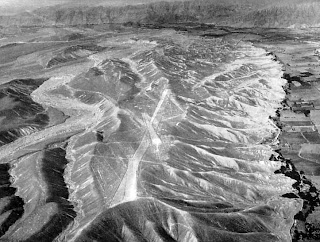The organization of a machine [system]…only states relations between components and rules for their interactions and transformations…
- Humbert Maturana & Francisco Varela
Autopoiesis and Cognition 1972
Generally, a system is a set of components defined by ‘their interactions and transformations.’ The high-level organization of a system emerges from consistently enacted behaviors among low-level components. Specifically, architects work with systems that have dynamic and structural qualities. Dynamically, systems deal with transformation and movement. Structurally, systems deal with organization and pattern. Also note that systems can be conceptual and/or physical.
Louis Kahn – Vehicular and pedestrian traffic flow study for Philadelphia city center

George Kubler – Photograph of the Palpa Lines
Kahn’s Philadelphia city center diagram studies a system that manages the movement of traffic in an urban landscape. This system is dynamic (movement of traffic), structural (spatial relations), and conceptual (the design was not realized, but used to think about how a could work). The Palpa Lines are a system that inscribes pattern onto a geologic landscape. This system is structural (legible pattern introduced to the natural landscape) and physical (the design was realized). Both of these systems operate on landscape, one urban and one geologic.
INHABITABLE LANDSCAPE
Conceive a system that augments your landscape to make it inhabitable for human bodies. This system will be comprised of basswood attachment components touching down on the existing landscape and basswood surface components that create surfaces and enclosures for bodies.
Build this system in the large-scale (1/4” = 1’-0”) foam landscape. Keep figures in the model to gauge scale. Developing a system is developing a procedural way of working; prioritize a systematized material practice over preconceived notions of inhabitation.
SYSTEM DIAGRAM
Diagram the dynamic and structural aspects of the new system. The dynamic aspects will deal with the potential flows of bodies across surfaces (specifically, how and where do bodies move). The structural aspects will deal with spatial relations between existing landscape and basswood attachment components (specifically, how and where are attachments made, how and where are surfaces located). Consider how the system operates both physically and conceptually. This diagram will be an extension of the material analysis drawings (modeled in Rhino, graphics and notations in Illustrator).









